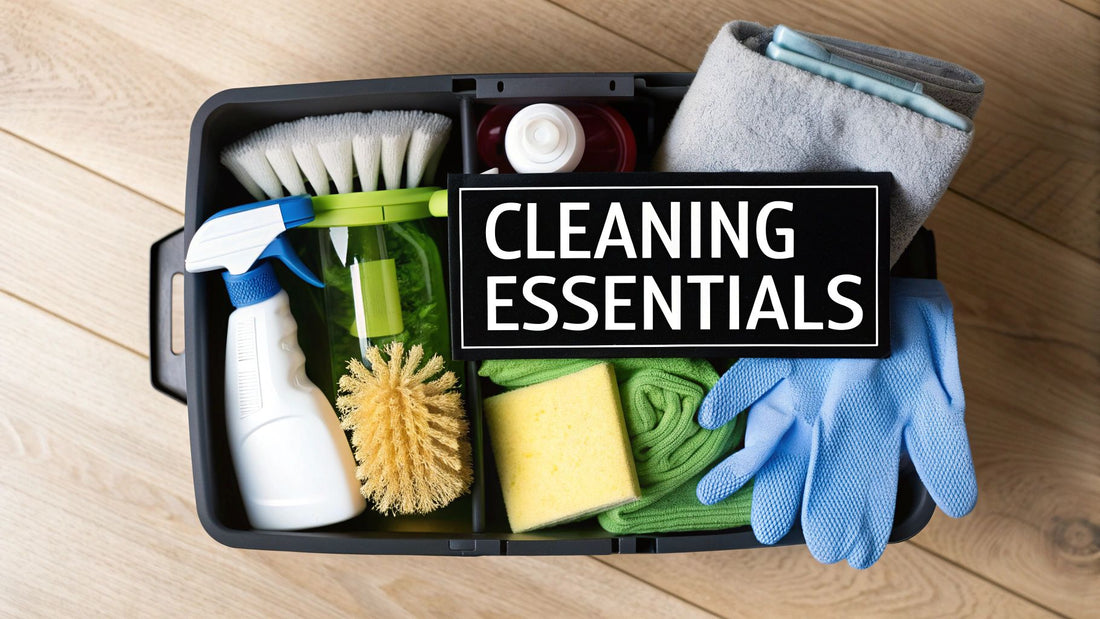Ready for a Spotless Home? Start With the Right Tools
Keeping your home consistently clean doesn't require an overwhelming collection of specialized products. The secret to an efficient and effective routine lies in having a well-stocked, foundational toolkit. Forget cluttered cabinets filled with single-use gadgets and harsh chemicals; a streamlined approach with the right core items saves you time, money, and effort. This guide provides the ultimate basic cleaning supplies checklist, cutting through the noise to focus on the essentials.
We will break down the must-have items every household needs to tackle daily messes and deep cleans alike. Moving beyond a simple shopping list, we’ll explain why each tool earns its place, how to select the best options for your specific needs, and professional tips for maximizing their power. Whether you are a new homeowner assembling your first cleaning caddy or looking to simplify your current arsenal, this definitive list ensures you are properly equipped to maintain a spotless, welcoming space. Let's build your perfect cleaning kit.
1. All-Purpose Cleaner
The cornerstone of any effective cleaning kit is a high-quality all-purpose cleaner. This versatile workhorse is designed to tackle dirt, grease, and grime on a wide variety of non-porous surfaces, making it an indispensable part of your basic cleaning supplies checklist. Its power comes from a formulation of surfactants that lift soil and solvents that dissolve stubborn messes, simplifying your routine by eliminating the need for a dozen different specialized products.
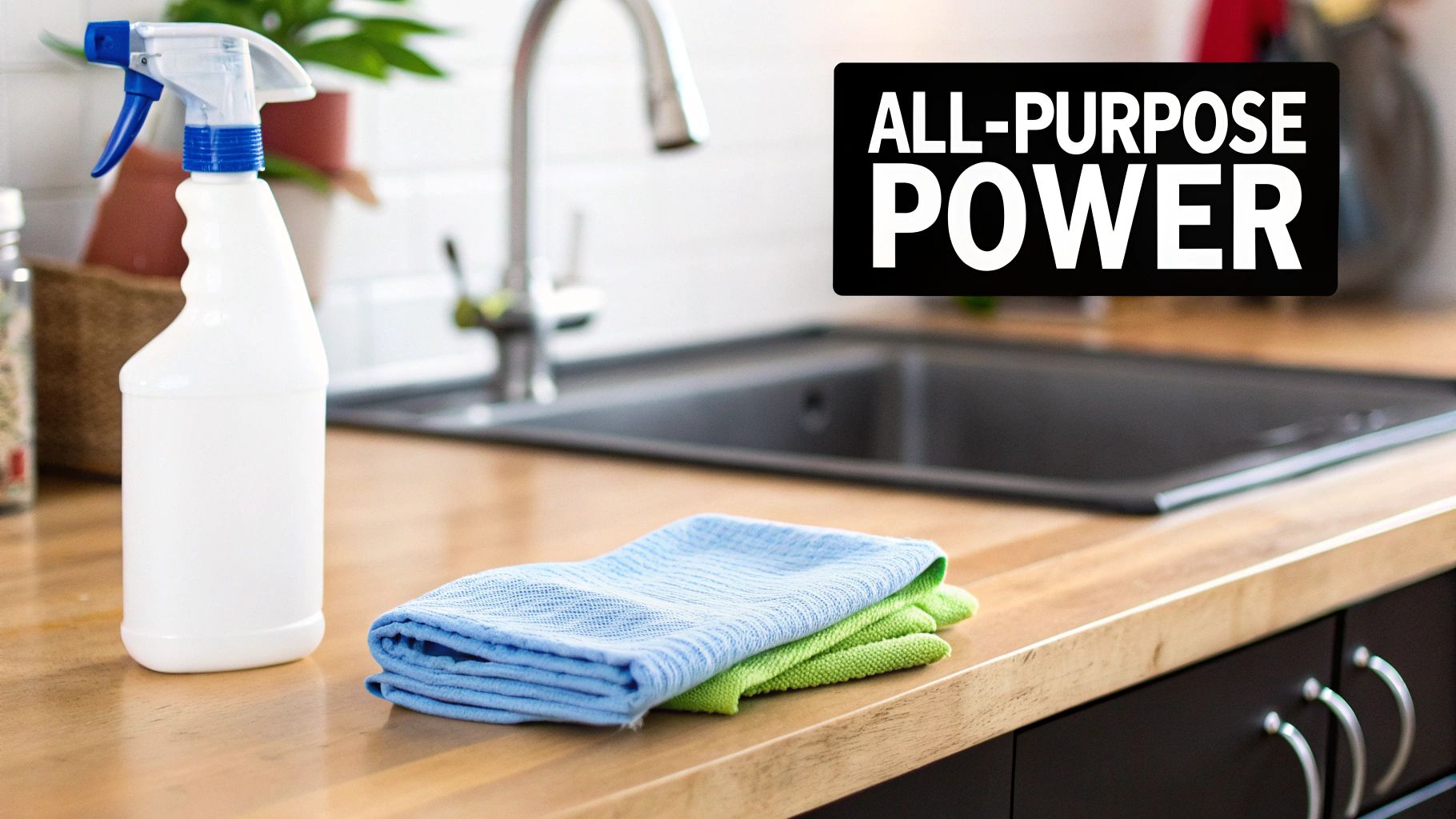
From wiping down kitchen countertops and the exterior of appliances to cleaning baseboards and even spot-treating walls, its utility is unmatched. Some formulations, like Lysol All-Purpose Cleaner, also include disinfectants to kill germs and bacteria, providing an extra layer of protection for your home. Eco-friendly options like Simple Green offer powerful cleaning with plant-derived ingredients.
Pro-Tips for Maximum Effectiveness
To get the most out of your cleaner, always follow a few key steps.
- Test First: Before applying it to a large or visible area, test the cleaner on a small, inconspicuous spot (like the back of a piece of furniture or an underside of a countertop) to ensure it doesn't cause discoloration or damage.
- Allow Dwell Time: For disinfecting or tackling tough, baked-on messes, spray the surface and let the cleaner sit for 3 to 5 minutes before wiping. This "dwell time" allows the active ingredients to break down grime and kill pathogens effectively.
- Pair with Microfiber: Using a microfiber cloth instead of a paper towel will trap more dirt and result in a gleaming, streak-free finish.
Understanding the different types available is key. If you're unsure where to start, you can get help with choosing the right cleaning products for your home.
2. Microfiber Cloths
Far superior to old rags or paper towels, microfiber cloths are a non-negotiable part of any modern basic cleaning supplies checklist. These advanced cloths are made from ultra-fine synthetic fibers, typically a blend of polyester and polyamide, that are split into microscopic strands. This design creates a vast surface area with a positive charge that acts like a magnet for negatively charged dust, dirt, and bacteria, trapping them within the fibers instead of just pushing them around.
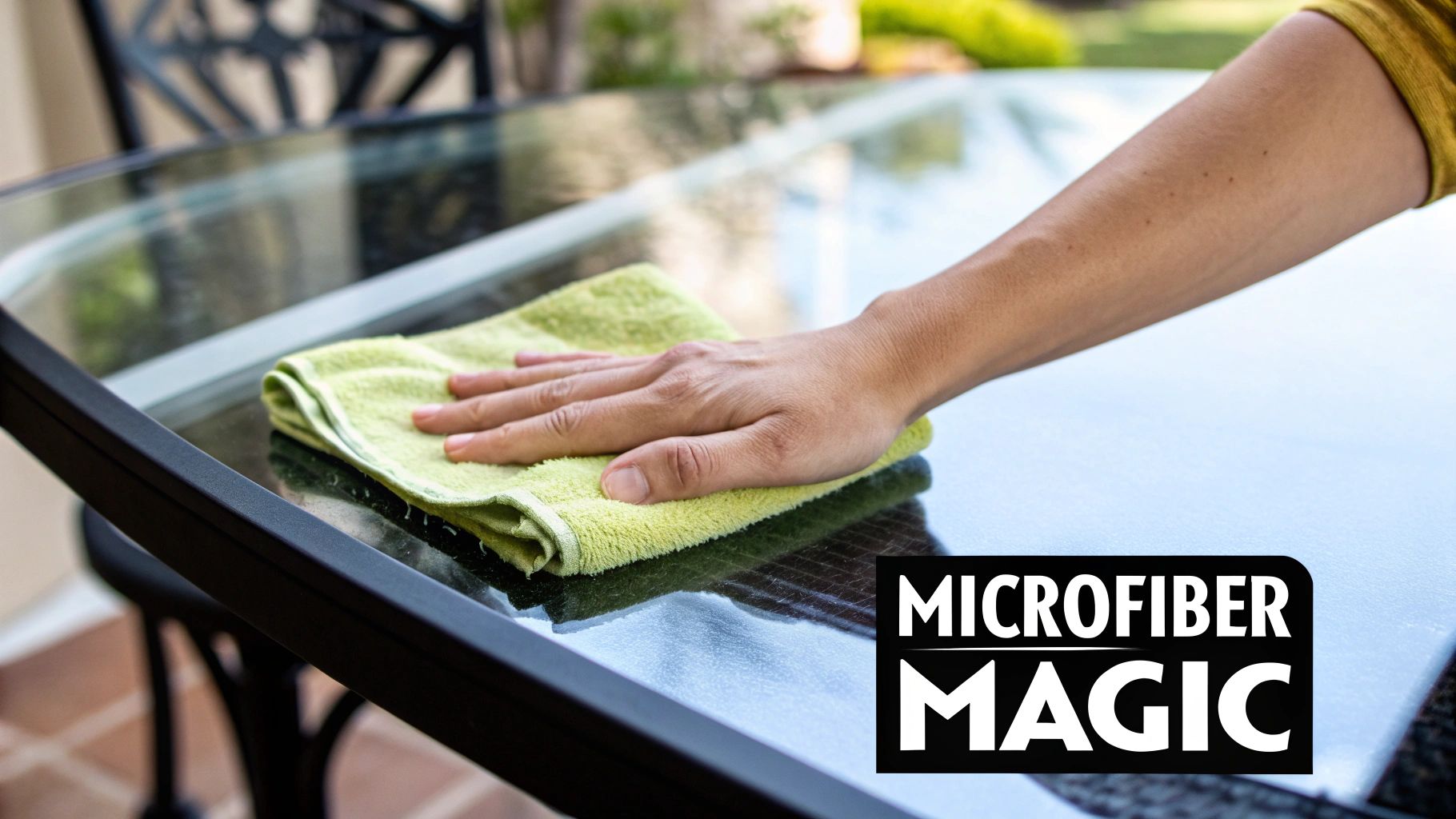
The remarkable effectiveness of microfiber allows for exceptional cleaning with just water, reducing the need for harsh chemicals. Brands like E-Cloth and Norwex have built entire cleaning systems around this principle, while more budget-friendly options are widely available for general use. Their absorbency and streak-free performance make them ideal for everything from dusting furniture and polishing glass to wiping down stainless steel appliances and scrubbing bathroom fixtures.
Pro-Tips for Maximum Effectiveness
To keep your microfiber cloths performing at their peak, proper use and care are essential.
- Color-Code Your Cleaning: Assign different colored cloths to different rooms or tasks (e.g., blue for glass, yellow for the kitchen, red for bathrooms). This simple system is a professional trick that effectively prevents cross-contamination between high-germ and food-prep areas.
- Wash Correctly: Clean your cloths by washing them in hot water with a small amount of detergent. Crucially, never use fabric softener or bleach, as these products will clog the fibers and destroy their static charge, rendering them ineffective. Air-dry or tumble dry on a low-heat setting.
- Use Damp, Not Soaking: For most tasks, a lightly dampened cloth is all you need. For dusting, use it dry. For scrubbing, use it wetter. Using too much water can limit the fibers' ability to pick up grime.
3. Dish Soap
While its name suggests a singular purpose, dish soap is a powerful and surprisingly versatile degreaser that earns a non-negotiable spot on any basic cleaning supplies checklist. Its true strength lies in its concentrated formula of surfactants, which are engineered to aggressively break down and lift grease, oil, and stubborn food particles from surfaces. This gentle yet potent action makes it a multi-purpose cleaner that extends far beyond the kitchen sink.
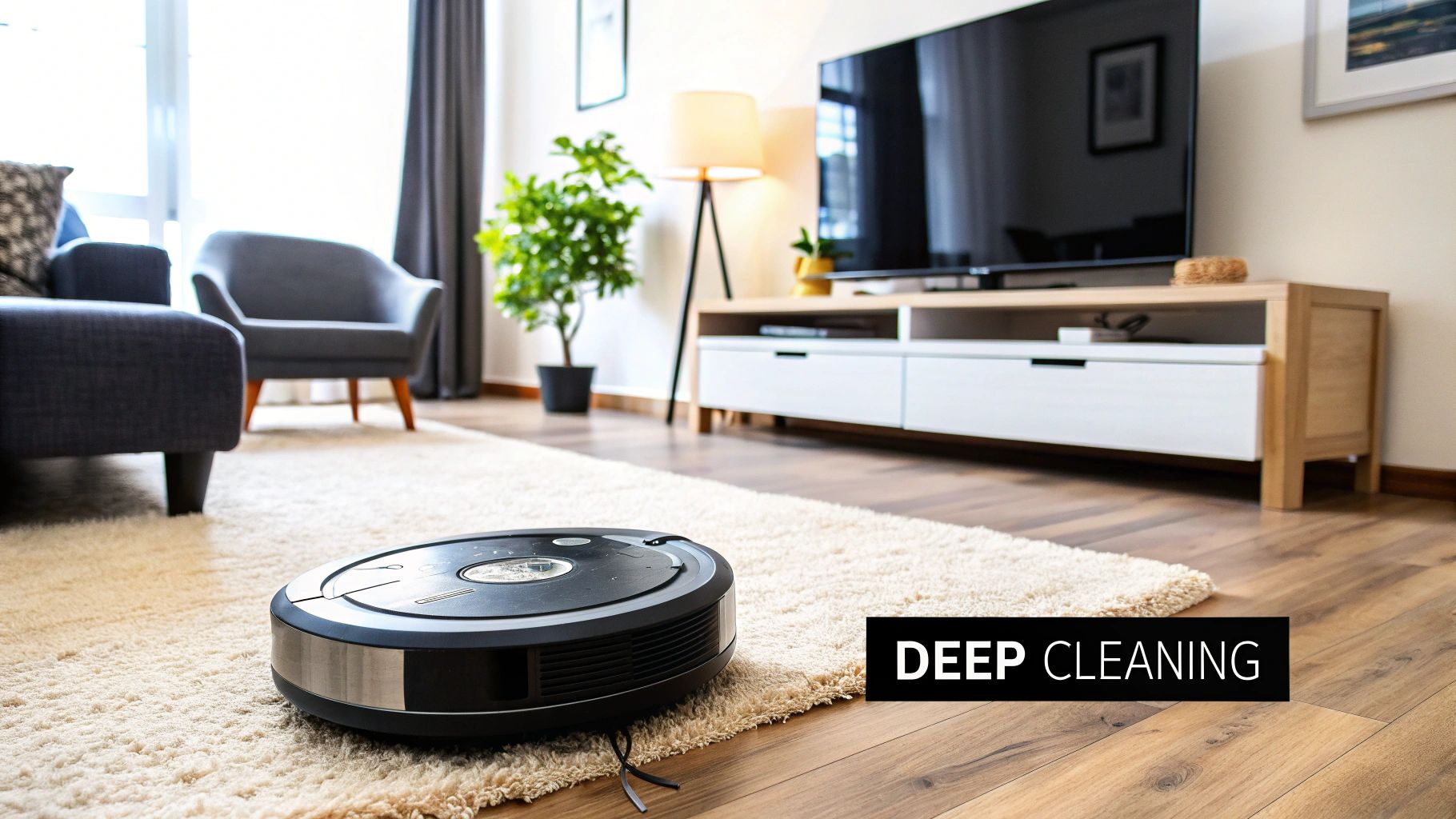
Beyond hand-washing dishes, dish soap can be used to clean greasy stovetops, pretreat laundry stains, and even create a safe and effective solution for cleaning outdoor furniture. Brands like Dawn are famously used for heavy-duty degreasing tasks, while eco-friendly options from Seventh Generation provide excellent cleaning power for those with environmental concerns. A few drops diluted in water can handle countless household chores.
Pro-Tips for Maximum Effectiveness
To leverage this everyday item for whole-home cleaning, keep these tips in mind.
- Create a Gentle Surface Cleaner: Mix a few drops of dish soap into a spray bottle filled with warm water. This solution is perfect for wiping down countertops, cabinets, and even vinyl or linoleum floors without leaving harsh chemical residues.
- Make a Scrubbing Paste: For tougher grime on sinks, tubs, or tile grout, combine dish soap with baking soda to form a thick paste. Apply it to the area, let it sit for a few minutes, and then scrub away with a brush before rinsing.
- Use Sparingly: Dish soap is highly concentrated, so a little goes a very long way. Using too much will create excessive suds that are difficult to rinse completely, potentially leaving behind a sticky film.
4. Glass Cleaner
No basic cleaning supplies checklist is complete without a dedicated glass cleaner. This specialized solution is engineered to deliver a sparkling, streak-free finish on windows, mirrors, and other glass surfaces. Its magic lies in its fast-evaporating ingredients, such as alcohol or ammonia, which cut through fingerprints, smudges, and soap scum without leaving behind residue. This targeted formula ensures crystal-clear results that general-purpose cleaners often struggle to achieve.
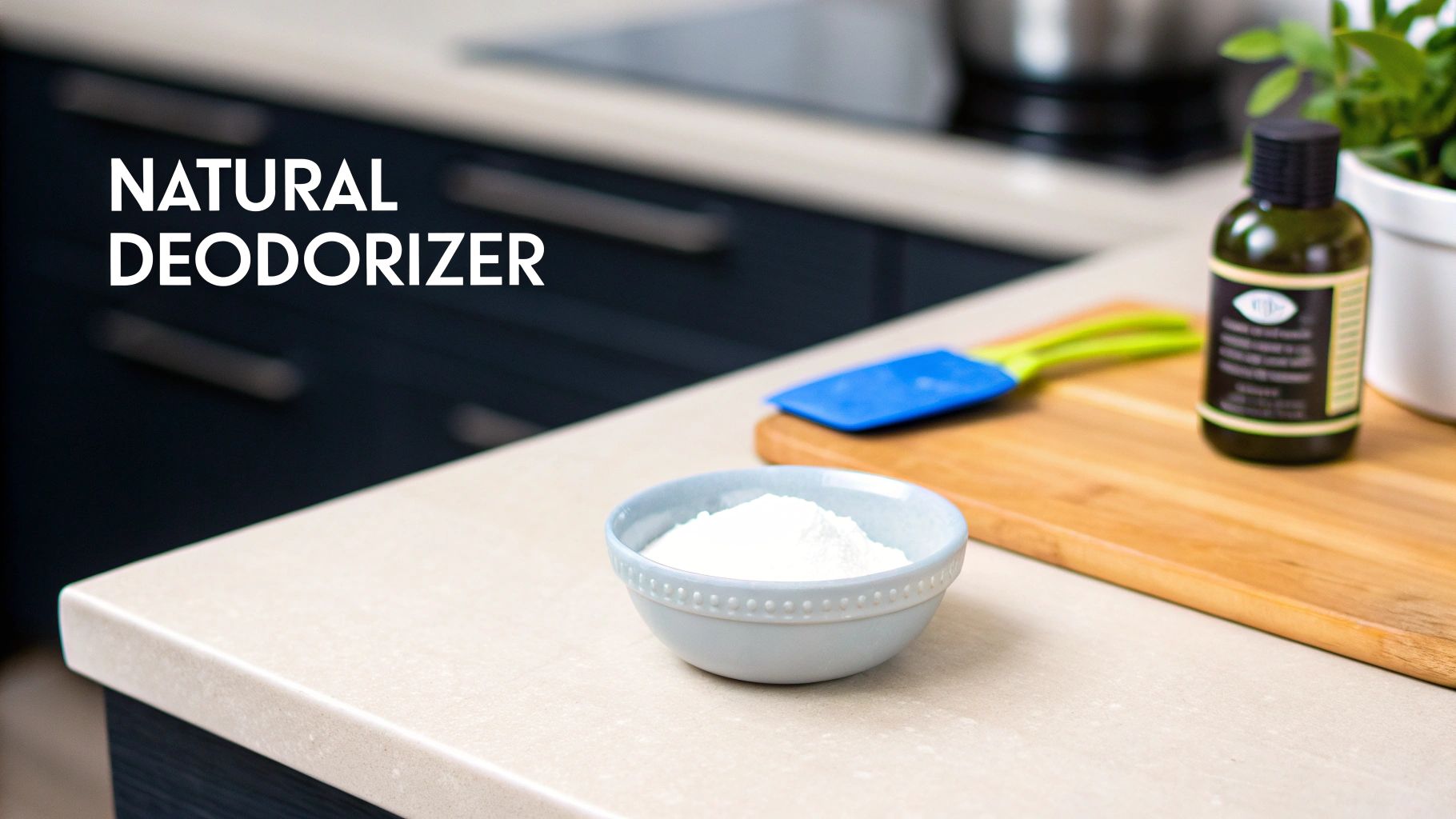
From bathroom mirrors to picture frames and glass tabletops, its applications are numerous. Classic options like Windex have been a household staple for decades, while products like Sprayway Glass Cleaner offer a foam-based, no-drip solution favored by professionals. The right glass cleaner elevates your home's appearance, allowing natural light to pour in and making spaces feel brighter and more open.
Pro-Tips for Maximum Effectiveness
For a flawless finish, apply these expert techniques.
- Avoid Direct Sunlight: Clean glass when it is in the shade or on a cloudy day. Direct sun can cause the cleaner to evaporate too quickly, creating streaks before you can wipe them away.
- Use the Right Tool: While paper towels work, a tightly woven microfiber cloth, a squeegee, or even a crumpled piece of newspaper will give you a superior, lint-free shine.
- Work Top to Bottom: Always clean the window frames and sills first to prevent dirt from dripping onto your just-cleaned glass. When wiping the glass, use a circular motion to lift grime, followed by vertical and then horizontal strokes for a streak-free result.
5. Disinfectant
While cleaners remove dirt, a dedicated disinfectant is crucial for eliminating harmful microorganisms. These chemical agents are specifically formulated to kill or inactivate viruses, bacteria, and fungi on non-porous surfaces. An essential item for any basic cleaning supplies checklist, disinfectants provide peace of mind by creating a more hygienic environment, especially in kitchens, bathrooms, and on frequently touched objects throughout your home.
Look for products that are EPA-registered, as this indicates they have been tested and proven effective against specific pathogens. Popular and effective options include Lysol Disinfectant Spray for aerosol application on hard and soft surfaces, or Clorox Disinfecting Wipes for quick, convenient cleaning of smaller items. Using these products correctly is key to safeguarding your family’s health, particularly during cold and flu season.
Pro-Tips for Maximum Effectiveness
To ensure your disinfectant works as intended, follow these critical steps.
- Pre-Clean First: Disinfectants are not designed to cut through heavy soil. Always clean the surface with an all-purpose cleaner first to remove dirt and grime, which allows the disinfectant to make direct contact with germs.
- Respect Dwell Time: This is the most crucial step. Spray or wipe the surface so it remains visibly wet for the entire contact time specified on the product label, often between 3 to 10 minutes. Wiping it dry too soon will prevent it from killing the germs.
- Focus on Hotspots: Regularly disinfect high-touch surfaces that can easily spread germs, such as doorknobs, light switches, faucet handles, remote controls, and refrigerator doors.
Proper application makes all the difference. You can learn how to disinfect high-traffic areas to better protect your home.
6. Vacuum Cleaner
No basic cleaning supplies checklist is complete without a powerful vacuum cleaner. This essential appliance is the most effective tool for removing dirt, dust, pet hair, and allergens from floors and upholstery. By using powerful suction, it lifts debris from deep within carpet fibers and crevices in hard floors, capturing particles that sweeping or dusting might just move around. Its ability to improve air quality by trapping allergens makes it a cornerstone of a truly clean home.
From versatile Dyson cordless models ideal for quick cleanups to the budget-friendly power of a Shark Navigator, there is a vacuum for every need. The introduction of automated options like the Roomba has further revolutionized home cleaning. Each type, whether upright, canister, stick, or robotic, is designed to meet different challenges, from large carpeted areas to tight corners and underneath furniture.
Pro-Tips for Maximum Effectiveness
To keep your vacuum performing at its best and your home spotless, follow these simple guidelines.
- Maintain Suction Power: For bagless models, empty the dust canister when it is about half full. Allowing it to overfill can significantly reduce suction and cleaning efficiency. For bagged models, change the bag before it gets completely packed.
- Follow a Schedule: Vacuum high-traffic areas like entryways and living rooms at least twice a week to prevent dirt from getting ground into the fibers. For less-used spaces, once a week is typically sufficient.
- Use Your Attachments: Don't neglect the crevice tool, dusting brush, and upholstery attachment. Using the right tool for baseboards, furniture, and tight spots ensures a much more thorough clean than using the main vacuum head alone.
Understanding how different models can fit your lifestyle is crucial. For those with busy schedules, it can be helpful to learn about the benefits of robotic vacuums.
7. Toilet Bowl Cleaner
No basic cleaning supplies checklist is complete without a dedicated toilet bowl cleaner. This specialized product is formulated to tackle the unique challenges of a toilet, such as mineral deposits, stubborn stains, bacteria, and odors. Its power comes from either acidic or bleach-based formulas that dissolve hard water rings and limescale while disinfecting the porcelain surface. Many feature an angled neck design to ensure the liquid reaches under the rim for a comprehensive clean.
Unlike an all-purpose cleaner, these products are designed to cling to vertical surfaces, giving the active ingredients more time to work. Lysol Toilet Bowl Cleaner is excellent for disinfecting during weekly cleanings, while powerful options like The Works Toilet Bowl Cleaner are made to dissolve severe rust and mineral stains. Others, like Scrubbing Bubbles, use a foaming action to lift grime with less manual effort.
Pro-Tips for Maximum Effectiveness
To achieve a sparkling and hygienic toilet, follow a few key steps.
- Ensure Adequate Dwell Time: For maximum sanitizing and stain-fighting power, apply the cleaner evenly under the rim and around the bowl. Let it sit for at least 10 to 15 minutes before scrubbing. This allows the chemicals to break down grime and kill germs effectively.
- Ventilate the Area: Toilet bowl cleaners often contain strong chemicals. Always turn on the bathroom fan or open a window during use to ensure proper air circulation and avoid inhaling potent fumes.
- Scrub After Soaking: After the cleaner has had time to work, use a sturdy toilet brush to scrub the entire bowl, paying special attention to the water line and under the rim. This final step removes loosened debris and ensures a uniform clean.
8. Baking Soda
An unsung hero of the cleaning world, baking soda (sodium bicarbonate) is a naturally occurring alkaline compound that serves as one of the most versatile and eco-friendly agents available. This household staple deserves a permanent spot on your basic cleaning supplies checklist due to its powerful deodorizing and gentle abrasive properties. It works by neutralizing acidic odors and providing a mild scouring action that cleans surfaces without scratching them, making it a safe yet effective alternative to harsh chemical cleaners.
From scrubbing tough grime off pots and pans to freshening up carpets and refrigerators, its uses are nearly endless. The iconic Arm & Hammer brand has championed its cleaning prowess for over a century. A simple paste of baking soda and water can lift stubborn stains from countertops, sinks, and even grout lines. Its ability to absorb and neutralize odors makes it perfect for placing in an open box inside your fridge or sprinkling into a smelly trash can.
Pro-Tips for Maximum Effectiveness
To leverage this multi-purpose powder, consider these simple yet powerful applications.
- Create a Scouring Paste: For tough jobs like cleaning oven interiors or stained sinks, mix baking soda with a small amount of water to form a thick paste. Apply the paste, let it sit for 15-20 minutes to break down grime, and then scrub with a damp sponge before rinsing.
- Deodorize Before Vacuuming: Before you vacuum, lightly sprinkle dry baking soda over your carpets and rugs. Let it sit for at least 15 minutes (or longer for stronger odors) to absorb musty smells, then vacuum it up for a refreshed room.
- Unclog Drains Naturally: Pour about a half-cup of baking soda down a slow-moving drain, followed by a half-cup of white vinegar. The fizzing reaction helps dislodge minor clogs. Let it sit for 30 minutes, then flush with hot water.
Basic Cleaning Supplies Comparison
| Item | 🔄 Implementation Complexity | ⚡ Resource Requirements | 📊 Expected Outcomes | 💡 Ideal Use Cases | ⭐ Key Advantages |
|---|---|---|---|---|---|
| All-Purpose Cleaner | Low - easy spray or wipe use | Moderate - chemical solutions | General surface cleanliness, grease and grime removal | Everyday cleaning of multiple surfaces | Versatile, cost-effective, often antibacterial |
| Microfiber Cloths | Low - simple wiping technique | Low - reusable cloths | Effective dust and bacteria removal with water | Dusting, safe delicate surface cleaning | Chemical-free, highly absorbent, reusable |
| Dish Soap | Low - straightforward liquid use | Low - concentrated detergent | Effective grease removal, surface cleaning | Dishwashing, light household cleaning | Gentle, versatile, economical |
| Glass Cleaner | Low - spray and wipe | Low - specialized solvent formula | Streak-free, clear glass and mirrors | Glass surfaces, mirrors, windows | Fast drying, streak-free shine |
| Disinfectant | Moderate - requires specific contact | Moderate to High - chemical agents | Pathogen elimination and surface hygiene | High-touch areas, healthcare, bathrooms | EPA-registered, broad-spectrum antimicrobial |
| Vacuum Cleaner | High - requires mechanical operation | High - electricity and maintenance | Deep cleaning of carpets and floors, allergen removal | Large floor areas, carpets, upholstery | Highly effective, improves air quality |
| Toilet Bowl Cleaner | Low to Moderate - apply and scrub | Moderate - acidic or bleach agents | Removes stains, mineral deposits, and disinfects | Toilet bowls and bathroom fixtures | Targets tough toilet stains, disinfecting |
| Baking Soda | Low - simple application | Very Low - inexpensive powder | Odor neutralization, mild abrasive cleaning | Deodorizing, gentle scrubbing | Natural, non-toxic, versatile |
From Checklist to Clean: Putting Your Supplies into Action
Transitioning from a list on a page to a sparkling, well-maintained home is where the real satisfaction begins. This basic cleaning supplies checklist isn't just a shopping list; it's a foundational toolkit designed for maximum efficiency. By now, you understand that these eight core items, from the gentle abrasion of baking soda to the streak-free shine of a quality glass cleaner, can handle the vast majority of your home’s cleaning needs. The power lies not just in owning these supplies, but in understanding how to leverage their unique strengths.
Mastering this core set allows you to clean with purpose and precision. Instead of grabbing a random bottle, you’ll know to reach for dish soap to tackle greasy kitchen messes or a dedicated disinfectant for high-touch surfaces during cold season. This strategic approach saves you time, money, and effort, transforming daunting chores into manageable tasks. You've equipped yourself with the knowledge to create a cleaner, healthier, and more comfortable living environment.
The ultimate benefit of this curated checklist is empowerment. You now have the essential arsenal to maintain your space, whether you're a new homeowner in Michigan setting up your first utility closet or a long-time resident looking to simplify your routine. Consistent action, armed with the right tools, is the secret to a perpetually clean home.
Your Next Step to a Spotless Home
If assembling your cleaning kit and dedicating the time still feels overwhelming, remember that you don't have to manage it all on your own. For homeowners and businesses across Mid-Michigan, professional support is a valuable and time-saving option. A reliable service brings not only their expertise but also their own professional-grade supplies, taking the guesswork and effort completely off your plate.
For those in Michigan seeking a trusted partner, Custom Maids has provided exceptional cleaning services since 1982. We handle everything from one-time deep cleans to recurring maintenance, allowing you to enjoy a pristine home without lifting a finger. Ready to reclaim your time and experience a truly professional clean? Contact Custom Maids today for a free consultation and let us put our expertise to work for you.

